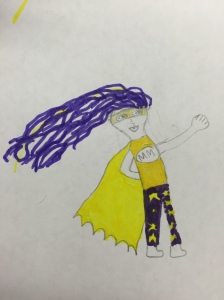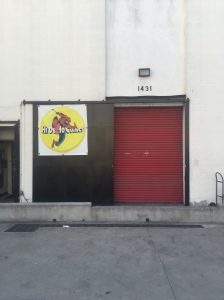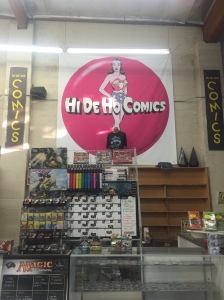Superman has been long held as the original superhero. He is the first to break out into the genre and really stick. We have seen his story told over the past 80 years, and he is one of the most recognizable figures in American culture. And yet, from his conception there has been the desire to hide him, to keep him hidden. His alter ego/secret identity Clark Kent is introduced within five pages of his comic. Throughout the comics he continues to go back and fourth between these two identities. He keeps his identity as Superman secret, while living daily as Clark Kent. A complete 180 from his super identity, Clark is “a mild-mannered reporter” who can’t seem to be tough enough to impress his love interest Lois Lane (DC Comics). He is a little clumsy and seems to be very shy. In these early comics Lois cannot stand Clark, yet pines over Superman, unaware that they are the same person. Presenting himself as Clark only seems to put him at a disadvantage. It keeps him separated from the girl he likes and causes him to have to keep the secret of, what I believe is his true identity.
Before Superman becomes Clark, he begins his life as Kal-El. He was born on the planet Krypton and given that name there. Upon his arrival on Earth his super strength increases, and from infancy he is “Super”. The alias of Clark Kent is created around him to hide his identity, yet it is neither of his true identities. It is not his Kal-El given name, nor is it who he truly is as a character. He must “put on a mask” so to speak (his glasses) and hide his true self. This character does Superman a disservice, because it alienates him further than the alien he already is. There is no identity to protect, at least in the earliest comics, because there are no established villains outside of typical human issues (rich fat cats for example). The effect of Superman being known as such doesn’t seem to be very threatening. In fact, it would only help him to not be the shy and goofy Clark Kent. It is very odd that such a powerful character would take on such a wimpy persona. The true him is not a wimp by any stretch of the imagination, so why feel the need to play one? This affects his life at work as well as his love life. If he were to be revealed as Superman, he could live freely as himself, and not a made up alias so diametrically opposed to his true self.
The superhero Spider-Man, however, differs from Superman here. While Superman has always been super, making that his true identity, Spider-Man was first Peter Parker. He lived as Peter Parker for fifteen years before that fateful day when the radioactive spider bit him. Upon becoming Spider-Man he must now reconcile the two parts of him. He is both still Peter, while also adding on to his true self. This contrasts Superman, as he had always been super and created Clark Kent. Peter Parker had always been that, but then becomes a superhero, making that his alternate identity, but one that can still go with who he is as a person. It doesn’t change his personality so far from himself that he is no longer recognizable. Both Peter and Spidey flow together very nicely. They share the same morals and perspectives on life. From an audience standpoint, Spidey and Parker are reconcilable characters. Neither side has to put on an act in order to portray the other. They go hand in hand with what the other feels. Superman, however, is not like this. He has created up an alternate identity for himself that is not reconcilable with his superhero self. It must be kept very separate and consciously different. Superman and Clark do not share very many qualities.
Here I want to go more in depth about the secret identity as a convention of superheroes. Why it is important/why it isn’t. There is potential here to bring up superheroes that either lack an alias (are only known as their superhero self) or who are known as who they were before becoming super and who they are after. And example of the latter is Captain America, as his identity is publically known. He is still a successful superhero, despite people knowing who he is. Same goes for Iron Man. The convention of the secret identity seems to be outgrown at a certain point. (Possibly bring up how the convention is made fun of in The Incredibles—they only need put on an eye mask and suddenly their identities are hidden).
Works Cited/Referenced
“Captain America.” Marvel. Marvel Comics, n.d. Web. 29 April 2015.
Lee, Stan and Steve Ditko. Amazing Fantasy #15. Web.
Seigel, Jerry and Joe Shuster. Superman #53. Web.
Siegel, Jerry and Joe Shuster. The Superman Chronicles. New York: DC Comics, 2013.
Print.
“Spider-Man.” Marvel. Marvel Comics, n.d. Web. 29 April 2015.
“Superman.” DC. DC Comics, n.d. Web. 29 April 2015.
***Thank you for taking the time out to read my paper! I know this is a VERY rough draft. I still feel very uncertain about how to go about arguing my perspective with research. Professor Hatfield has directed me to some very great works from the library, but unfortunately my schedule this week has not allowed me to get over there yet. For my final draft I of course will have many more academic sources, as well as a complete paper. If you have read my paper and believe you have any sort of input or help for me, PLEASE comment below! I am looking for as much feedback and input as possible. I know that what I have written above is not a solid paper, but I am looking at it as more of a very detailed outline, or at least an outline written to look like a paper. Again, thank you for reading, and please do not hesitate to critique, give feedback, or any input for that matter!




